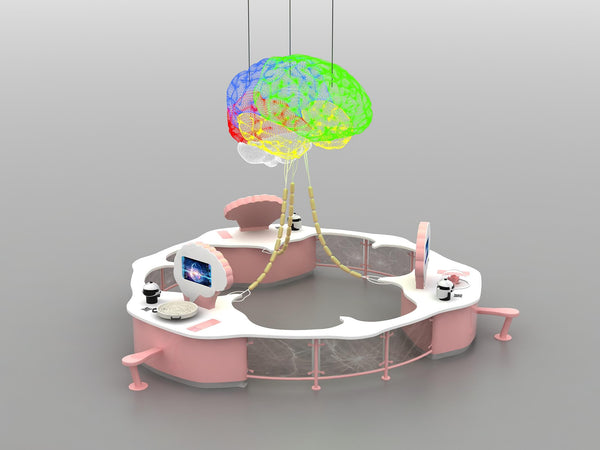interactive museum exhibits:Exploring the Mysteries of the Brain

Blog Post: Exploring the Mysteries of the Brain
Unveiling the Secrets of the Brain: A Journey Through Science
In every corner of a science museum, certain exhibits captivate visitors' attention. The brain model display is one such masterpiece. This meticulously designed brain exhibit not only allows visitors to understand the structure and function of the brain but also offers rich interactive experiences, making it one of the most popular **interactive museum exhibits** in the human body section of the museum.
Core Exhibit: The Brain Model
At the heart of the exhibit lies an accurate brain model that showcases the main structures and functional areas of the brain. This model is not only lifelike but also vividly demonstrates neural signal transmission through three neuron models connected to a control console. Each neuron is annotated in detail, helping visitors comprehend how the brain processes information through its complex neural network.
Interactive Displays: In-Depth Brain Exploration
Surrounding the brain model are three large displays, each containing detailed information about the brain's interior. These displays allow visitors to delve into various parts of the brain, including the cerebral cortex, hippocampus, and brainstem. The content is rich, featuring 3D models, animated demonstrations, and detailed textual explanations, offering a comprehensive understanding of how the brain functions.
Display One: The anatomy of the brain. It showcases different regions of the brain and their functions, helping visitors understand how each part works together.
Display Two: Neurons and synapses. It explains the structure of neurons and their role in signal transmission, with animated demonstrations of the process.
Display Three: Brain functions and diseases. It introduces how the brain controls behavior and emotions, and highlights common brain diseases and their impacts.
Interactive Experiences: Engaging Scientific Exploration
In front of each display are various interactive models designed to engage visitors. These interactive elements not only enrich the exhibit content but also increase visitor participation and interest in learning. For example:
Memory Test: Through a series of memory games, visitors can experience how the brain stores and retrieves information.
Reaction Time Test: It tests visitors' reaction speeds, demonstrating how the brain quickly processes external stimuli.
Virtual Reality Experience: Using VR equipment, visitors can immerse themselves in a virtual world inside the brain, experiencing the transmission of neural signals firsthand.
Custom Design: Tailored to Different Exhibit NeedsThis brain exhibit system can be meticulously designed and customized to fit the client’s venue and exhibition environment. Whether for a large-scale science museum or a smaller educational display, the layout and content can be flexibly adjusted to provide the best possible presentation for visitors.
Conclusion
The brain exhibit system is not only a precise scientific display tool but also a gateway to the mysteries of human intelligence and consciousness. Through this exhibit, visitors can gain basic knowledge about the brain and enjoy the thrill of scientific exploration. This embodies the mission of science museums: to make knowledge lively and interesting and to inspire a love for science.The science museum invites you to explore the mysteries of the brain and embark on a fascinating scientific journey!
I hope this blog post effectively describes the features and appeal of the brain exhibit system, while also making it more understandable and searchable on Google. If you have any modifications or additional requests, please let me know.
